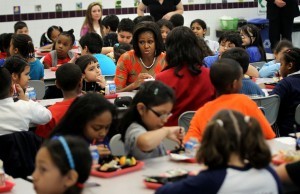by Julie Kelly and Jeff Stier
As Congress considers changes to the Healthy, Hunger-Free Kids Act (HHFKA), one little-known section of the law is expected to sharply increase the number of students receiving free lunch (and breakfast) over the next several years. This includes taxpayer-funded meals for students who would not have previously qualified under the old rules.
The Community Eligibility Provision (CEP) allows entire school districts, rather than individual families, to qualify for subsidized meals. This is a stark departure from how the program has been administered over the last 70 years, when families needed to prove financial need. Now, all students in a school district are eligible if more than 40 percent are low-income. So even if only half of the students actually qualify, every single student will receive a free breakfast and lunch each day.
This school year was the first time the CEP was fully implemented after a three-year pilot program. The number of participants — and cost of the program — is expected to rise again next school year. The USDA notes in its 2016 budget that “The main driver for the expected participation increase in school meals is the community eligibility provision (CEP).” The agency projects a 10% increase in the number of meals served next year (the school lunch/breakfast program costs about $15 billion and served about 8 billion meals this year.)
The USDA claims the CEP will “improve access for free meals in eligible high poverty schools” and “reduce the burden of collecting funds … for the students who pay for school meals.” Proponents claim this is actually “more cost-effective” because schools will “no longer handle school breakfast or lunch payments in the food line because there are no fees to collect.”
In Congressional testimony on June 16, Agriculture Secretary Tom Vilsack said “only half the schools that are eligible for this have adopted it.” Under the pilot program in 11 states, participation jumped dramatically: One study shows the number of students participating in the free lunch program nearly doubled in three years. All of Chicago’s 400,000 public school students received free breakfast and lunch thisyear, the first full year of national eligibility; nearly 72 million meals were served at all Chicago public schools at a cost of $225 million.
However, the new lax standards are inimical to the school lunch program’s original purpose. “This undermines the integrity of the program,” said a former USDA official who led the school lunch program years ago. Schools were supposed to sell lunches to kids who could afford them, which would partially subsidize the meals for those who couldn’t.
But while free lunch participation is rising, paying customers are dropping out. Since new nutrition standards were imposed requiring more fruits, vegetables and whole grains while limiting salt, sugar and whole dairy, USDA data shows participation among paying students has dropped by 1.5 million. The School Nutrition Association (SNA), warned about a decline in participation when the regulations were proposed in 2011.
Many schools are struggling to find ways to make meals palatable to notoriously picky eaters. “The standards have gone too far to the point of driving kids away from healthier meals,” said SNA spokeswoman Diane Pratt-Heavner. The group is asking for more flexibility at the local level. She cites regional concerns, such as student resistance to whole wheat tortillas in the southwest, whole grain cornbread in the south and bagels in the northeast.
Not only are the healthier choices turning the stomachs of paying students, many who receive the meals gratis are tossing their lunch. A lunch at a high school must offer five items, two of which are a fruit and vegetable. Even if the teen doesn’t want it, under the HHFKA, he/she must take either the fruit or vegetable item. “You can’t force kids to eat food they don’t want, they’ll just throw it in the trash,” said Heavner. This has caused a big spike in plate waste at schools. Heavner says 81 percent of SNA members surveyed reported an increase in food waste under the new standards. Similarly, a U.S. Government Accountability Office survey indicated food waste was the top concern of school professionals surveyed about problems with the HHFKA. (The USDA doesn’t currently track food waste in the school lunch program.)
Boosting child nutrition, lowering obesity rates and ensuring needy children receive meals are necessary and noble goals; perpetuating another costly federal entitlement program — which doesn’t deliver what it promises — is not. It’s time for Congress to fix the program.
Kelly is a food writer in Orland Park, Ill. Stier is a senior fellow at the National Center for Public Policy Research.





